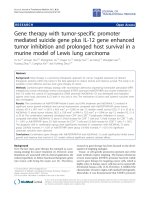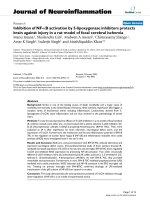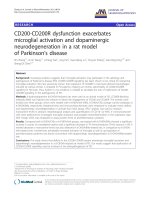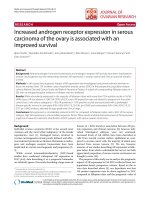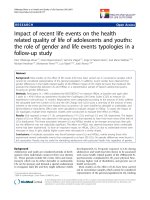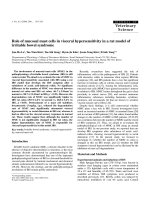Recovery effect of pre-germinated brown rice on the changes of sperm quality, testicular structure and androgen receptor expression in a rat model of drug addiction
Bạn đang xem bản rút gọn của tài liệu. Xem và tải ngay bản đầy đủ của tài liệu tại đây (1.24 MB, 8 trang )
Int. J. Med. Sci. 2018, Vol. 15
Ivyspring
International Publisher
921
International Journal of Medical Sciences
2018; 15(9): 921-928. doi: 10.7150/ijms.26076
Research Paper
Recovery effect of pre-germinated brown rice on the
changes of sperm quality, testicular structure and
androgen receptor expression in a rat model of drug
addiction
Samur Thanoi1,2, Jureepon Roboon1 and Sutisa Nudmamud-Thanoi1,2
1.
2.
Department of Anatomy, Faculty of Medical Science, Naresuan University, Phitsanulok, Thailand
Centre of Excellence in Medical Biotechnology, Faculty of Medical Science, Naresuan University, Phitsanulok, Thailand
Corresponding author: Samur Thanoi, PhD., Department of Anatomy, Faculty of Medical Science & Centre of Excellence in Medical Biotechnology, Faculty of
Medical Science, Naresuan University, Phitsanulok 65000, Thailand. Tel: +66 55 964600; Fax: +66 55 964770; E-mail:
© Ivyspring International Publisher. This is an open access article distributed under the terms of the Creative Commons Attribution (CC BY-NC) license
( See for full terms and conditions.
Received: 2018.03.15; Accepted: 2018.05.27; Published: 2018.06.12
Abstract
Drug addiction is reported to have adverse effects in male reproduction. Dextromethorphan
(DXM) administration was used in this study as a model of addiction in rats, and various treatments
including the use of pre-germinated brown rice (PGBR) were investigated for their effects on the
changes of sperm quality, testicular structure and androgen receptor (AR) expressions in rats
receiving DXM. The results demonstrated that these animals showed significant reduction in all
parameters of sperm quality, an increase in abnormal testicular structure and decreased androgen
receptor expression in spermatogenic, Sertoli and Leydig cells. However, different effects of the
treatments applied in this study were observed with the greatest recovery effect from treatment
with PGBR. Sperm motility and sperm concentration reverted to normal after treatment with PGBR
for 60 days. Moreover, all parameters of testicular structure also returned to normal after 60 days
of PGBR treatment, as well as AR expression in Sertoli and Leydig cells. Therefore, we have
demonstrated that PGBR treatment can reverse the changes in sperm quality, testicular structure
and AR expression in addicted animals and PGBR may be a novel therapeutic strategy for the
treatment of drug addiction.
Key words: Drug addiction, Dextromethorphan, Sperm quality, Testicular structure, Androgen receptor
Introduction
Drug addiction is reported to have adverse
effects on the male reproductive system including
disruption of the reproductive axis [1], reduced
testosterone [2,3] and decreased sperm quality
[4,5,6,7]. Furthermore, apoptosis of germ cells [6,7]
and decreased testosterone level [8] can be induced by
methamphetamine.
Dextromethorphan (DXM) is an antitussive or
cough suppressant drug. At high dosages, DXM can
act as a dissociative hallucinogen via multiple effects,
including as a nonselective serotonin reuptake inhibitor [9]. Within the past few years illicit use and drug
abuse of antitussive drugs, especially DXM, have
risen. Therefore, DXM was used in this study as a
model of drug addiction in rat.
We previously demonstrated that pre-germinated brown rice (PGBR) has a recovery effect on
improving sperm quality in a rat model of depression
[10]. PGBR is a food supplement which contains many
effective substances including 𝛾𝛾-oryzanol, α-tocopherol (vitamin E), pyridoxine (vitamin B6), thiamine
(vitamin B1) and high GABA [10]. Therefore, we
investigated whether PGBR would be an effective
treatment in this study in comparison with other
treatments including drug withdrawal, Diazepam (a
Int. J. Med. Sci. 2018, Vol. 15
common drug treatment for addiction), and standard
GABA (gamma-aminobutyric acid). The results from
this study will provide scientific information for the
potential use of a natural product as an alternative
treatment in improving testicular and sperm damages
caused by drug addiction.
Methods
Animals
Male Sprague-Dawley rats aging 5 weeks and
weighing between 200-250 g from National Animal
Center, Salaya, Nakorn Pathom, Thailand were used
in this study. The animals were housed at 24 ± 1 ◦C
under dark-light cycle 12:12 hours at Center for
Animal Research of Naresuan University. All animals
were treated according to the guidelines for animal
care and use of laboratory animals, and the protocols
were approved by the Animals Research Committee
of Naresuan University, Thailand.
922
• Dextromethorphan and drug withdrawal 60
days group (DW60): Animals were treated with
30 mg/kg DXM for 15 days (i.p.) and withdrawn
for 60 days, respectively.
• Dextromethorphan and diazepam 15 days group
(DD60): Animals were treated with 30 mg/kg
DXM for 15 days (i.p.) and treated with 10 mg/
kg diazepam for 60 days by oral administration
via gavage, respectively.
• Dextromethorphan and synthetic GABA 60 days
group (DG60): Animals were treated with 30
mg/kg DXM for 15 days (i.p.) and treated with
0.8 mg/kg synthetic GABA for 60 days by oral
administration via gavage, respectively.
• Dextromethorphan and PGBR 15 days group
(DP60): Animals were treated with 30 mg/kg
DXM for 15 days (i.p.) and treated with 5g/kg
PGBR for 60 days by oral administration via
gavage, respectively.
Drug and reagent administrations
The drug and reagents used in this study were
described below;
• Dextromethorphan (DXM); dextromethorphan
hydrobromide was purchased from SigmaAldrich® Lot#090M1298V.
• Diazepam was obtained from Naresuan University Hospital.
• Gamma aminobutyric acid; GABA was
purchased from Sigma Chemical Company, St.
Louis, USA. Amount of synthetic GABA was
equaled with the GABA found in PGBR. GABA
was dissolved in distilled water before used.
• Pre-germinated brown rice (PGBR) was supplied
by the Laboratory of Faculty of Agriculture
Natural Resources and Environment, Naresuan
University. Briefly, Brown rice (Oryza sativa var.
glutinosa) from KhekNoi, KhaoKho, Phetchabun
(Thailand) was soaked for 24 hours until germinated. PGBR was dried, ground to a powder
and suspended in distilled water before use.
Experimental design
The animals were divided into 6 groups with 7
animals each and treated as described below (Figure
1);
• Control group (Control): Animals were treated
with normal saline by oral administration via
gavage for 75 days.
• Dextromethorphan group (DXM): Animals were
treated with 30 mg/kg DXM via intraperitoneal
injection (i.p.) for 15 days and sacrificed on the
last day of treatment.
Fig. 1. The schematic diagram of experiment in rat model of addiction
Sample collection and Tissue preparation
After treatments, all animals were sacrificed by
cervical dislocation. The testes and epididymis were
immediately dissected and weighed. Sperm were
released from cauda epididymis in phosphatebuffered saline (PBS) at 37 °C and assessed for the
percentage of sperm motility. The remaining samples
were maintained and fixed in 10% formaldehyde for
evaluating sperm morphology and concentration.
Each testis was cut, placed in cassettes and
washed in PBS 3 times for 5 minutes. Then, the tissues
were processed for routine paraffin embedding until
sectioning. The tissue blocks were sectioned at 5 µm
thickness and sections were floated on warm water
(45 ◦C) in a water bath before mounting onto the
microscope slides coated with 3-(Triethoxysilyl)propylamine (S6225919 110; Merck, Hohenbrunn,
Germany). The sections were allowed to dry
overnight at room temperature before evaluating
testicular structure and androgen receptor expression.
Int. J. Med. Sci. 2018, Vol. 15
Sperm quality analysis
Sperm quality parameters including sperm
motility, sperm morphology and sperm concentration
were assessed. The protocols for each parameter
followed the protocol described by Roboon et al.
(2017) [10] briefly.
Sperm motility
Spermatozoa were assessed for the percentage of
sperm motility using a Makler counting chamber and
counted under bright field (40X objective lens). The
motile and non-motile sperm were evaluated and
calculated.
Sperm morphology
Spermatozoa were stained and assessed for the
percentage of normal sperm morphology with a total
count of 200 spermatozoa in each group.
Sperm concentration
Sperm concentrations were assessed using a
hemocytometer and counting under bright field (40X).
The results of sperm concentration were reported in
term of epididymal sperm number (106cells)/ml.
Testicular and epididymal structure analysis
Testicular and epididymal weight
Before being sacrificed, rats were weighed to
obtain body weight. After that, the testes and
epididymes were immediately dissected and
weighed. The data were evaluated and calculated as a
testicular/epididymal weight per body weight.
Morphological changes of seminiferous tubules
Morphological changes of seminiferous tubules
were analyzed followed the protocols described by
Roboon et al. (2017) [10]. Briefly, two sections per
animal were used. Each hematoxylin-eosin stained
section was evaluated under a light microscope
(Nikon eclipse 08i; Nikon, Bangkok, Thailand, Co.,
Ltd.) and a picture taken using a computerised image
capture system (Nikon digital camera DXM1200c,
Nikon, Bangkok, Thailand, Co., Ltd.). The data were
shown as percentage of each morphological type of in
seminiferous tubule per total number of seminiferous
tubules in each section.
Immunohistochemistry analysis (Expression of
androgen receptor)
Androgen receptor (AR) expression was
detected in rat testis by using the indirect
immunohistochemistry technique. Briefly, testicular
sections were deparaffinized and rehydrated. After
that, the antigen was retrieved with high temperature
heating at 70P or 560 Watt in microwave for 5
923
minutes, 3 times. Then, the sections were incubated
with endogenous peroxidase blocking solution (10%
methanol, 0.3% H2O2, 1% triton-X and PBS) for 30
minutes and washed with PBS 3 times for 5 minutes
each. The sections were incubated with non-specific
protein blocking solution (5% normal goat serum and
PBS) for 2 hours. After that, the sections were
incubated with AR primary antibody (Rabbit
polyclonal IgG, Santa Cruz Biotechnology, USA and
Merck Millipore, US) at a dilution of 1:25 in PBS
containing 5% normal goat serum for 4 hours. The
sections were then washed with PBS 3 times and
incubated with biotinylated secondary antibody for 2
hours and washed with PBS 3 times. Then the sections
were incubated with avidin-biotinylated horseradish
peroxidase complex (ABC kit) (Vector Laboratories,
Burlingame, California, USA) for 60 minutes and the
sections were washed with PBS 3 times for 5 minutes
each. The specific proteins were visualized with
chromogen 3,3’-Diaminobenzidine (DAB) (Vector
Laboratories, Burlingame, California, USA) for 6
minutes and rinsed in distilled water for 5 minutes.
The sections were dehydrated in a series of increasing
alcohol concentrations, and alcohol removed with
xylene. Finally, the tissues were mounted with
mounting media (Fisher scientific, New Jersey, USA).
Each immunostained section was evaluated
under a light microscope at magnification 20X using
the computerized image capture system. Two sections
per animal were used and 10 seminiferous tubules
were randomly selected from each section. AR
immunopositive cells were analyzed by ImageJ
software ( The data were
presented as percentage of positive cells per total cell
number.
Statistical analysis
Data were analyzed by one-way analysis of
variance (ANOVA). The statistical significances were
determined as p<0.05. The results were expressed as
mean±SEM.
Results
Sperm quality
Sperm motility
Rat sperm motility in the DXM group was
dramatically decreased (p<0.001) when compared to
the control group. Animal receiving DXM for 15 days
and treated with diazepam and GABA standard for 60
days showed a recovery in the percentages of sperm
motility but these were still significantly lower than
the control. Animals receiving DXM for 15 days and
withdrawn from this drug for 60 days and animals
treated with PGBR for 60 days showed percentages of
Int. J. Med. Sci. 2018, Vol. 15
924
recovery in sperm motility close to control values,
most notably in animals treated with PGBR (Table 1).
Sperm morphology
The percentage of normal sperm morphology in
animals treated with DXM alone also showed a highly
significant difference (p<0.001) when compared to the
control group. The percentages of normal sperm
morphology in animals in all treated groups
gradually recovered when compared with animals
treated with DXM alone but still showed significant
differences when compared with the control.
However, animals treated with PGBR showed the
most recovery in the percentage of normal sperm
morphology (Table 1).
weight when compared with the control group. There
was a significant increase in the percentage of
testicular weight/body weight (p<0.001), while the
percentage of epididymal weight/body weight was
decreased (Table 2).
Morphological changes of seminiferous tubules
All parameters of morphological changes in
seminiferous tubules showed significant increases in
animals treated with DXM alone. Additionally,
vacuolization and irregular tubules were also significantly increased in animals treated with diazepam.
Apart from that, other treated groups showed a
recovery effect of treatment reflected by no significant
differences when compared with controls (Table 2).
Sperm concentration
Expression of androgen receptor (AR)
Animal treated with DXM alone showed a
highly significant deficit in sperm concentration
(p<0.001) when compared with controls. Animals in
the groups of DXM with drug withdrawal for 60 days,
and DXM with diazepam for 60 days also showed
significant differences from controls. However,
animals treated with GABA standard and PGBR
showed no significant differences from the control
group (Table 1).
The percentages of AR expression in all cell
types measured in animals receiving DXM alone was
significant lower when compared to the control.
Similarly, significant decreases in AR expression in all
cell types were also found in animals following drug
withdrawal for 60 days and in animals treated with
diazepam. Animals treated with GABA standard and
PGBR showed a recovery effect in some cell types;
Leydig, Sertoli and peritubular myoid cells were not
significantly changed when compared to controls, but
spermatogonia, round spermatid and elongated
spermatid were still significantly affected (Table 3).
Testicular structure
Testicular and epididymal weight
Only in animals treated with DXM showed
significant changes in the testicular and epididymal
Table 1. Sperm quality parameters measured in the control, Dextromethorphan only and treatment groups: Control,
Dextromethorphan only (DXM), Dextromethorphan+Drug withdrawal (DW60), Dextromethorphan+Diazepam (DD60),
Dextromethorphan+GABA standard (DG60) and Dextromethorphan+Pre-germinated brown rice (DP60)
Parameter
Sperm Motility (%)
Normal Sperm Morphology (%)
Sperm Concentration
(x106/ml)
Control
65.07±3.37
92.79±0.69
260.06±8.05
DXM
2.86±2.86***
6.00±2.35***
18.19±3.01***
DW60
56.94±0.01
87.64±1.07***
215.68±7.87***
DD60
48.35±2.52**
84.36±0.83***
215.74±5.70***
DG60
54.40±2.65*
86.14±0.88***
252.30±3.84
DP60
60.74±2.51
89.50±0.80*
254.54±3.05
Values are expressed as mean±SEM. Statistical significance is indicated as *p<0.05, **p<0.01 and **p<0.001 in comparison with control group
Table 2. Testicular and epididymal weight and morphological changes of seminiferous tubules in the control, Dextromethorphan only and
treatment groups: Control, Dextromethorphan only (DXM), Dextromethorphan+Drug withdrawal (DW60), Dextromethorphan +
Diazepam (DD60), Dextromethorphan + GABA standard (DG60) and Dextromethorphan+Pre-germinated brown rice (DP60)
Parameter
Testicular weight/Body
weight
Epididymal
weight/Body weight
Separation of germinal
epithelium (%)
Vacuolization (%)
Luminal sloughing of
germ cells (%)
Irregular tubule
(%)
Atrophy (%)
Control
0.47±0.01
DXM
0.59±0.01***
DW60
0.45±0.01
DD60
0.48±0.01
DG60
0.46±0.02
DP60
0.43±0.01
0.14±0.01
0.09±0.01***
0.14±0.01
0.15±0.01
0.15±0.01
0.14±0.01
11.61±0.67
22.60±1.25***
13.31±0.98
14.54±1.73
12.48±0.86
12.16±0.76
3.16±0.14
0.51±0.04
5.16±0.32***
1.31±0.18**
3.32±0.28
0.50±0.06
3.93±0.15**
0.60±0.10
3.19±0.09
0.50±0.05
3.07±0.11
0.51±0.06
6.13±0.30
9.84±0.57***
6.91±0.19
10.53±0.98***
6.85±0.29
6.38±0.35
0.10±0.05
0.29±0.07*
0.14±0.03
0.14±0.03
0.11±0.04
0.11±0.03
Values are expressed as mean±SEM. Statistical significance is indicated as *p<0.05, **p<0.01 and **p<0.001 in comparison with control group
Int. J. Med. Sci. 2018, Vol. 15
925
Table 3. Percentages of androgen receptor (AR) expression in each cell type in the control, Dextromethorphan only and treatment
groups: Control, Dextromethorphan only (DXM), Dextromethorphan+Drug withdrawal (DW60), Dextromethorphan+Diazepam
(DD60), Dextromethorphan+GABA standard (DG60) and Dextromethorphan+Pre-germinated brown rice (DP60)
Parameter
Leydig cell
Sertoli cell
Spermatogonia
Round spermatid
Elongated spermatid
Peritubular myoid cell
Control
60.99±1.80
58.96±0.94
15.91±1.09
17.45±0.25
57.24±0.67
15.63±0.25
DXM
29.38±3.27***
32.09±2.46***
2.61±0.51***
8.07±0.685***
40.08±0.32***
10.13±0.07***
DW60
54.83±1.00*
58.77±0.27
7.01±0.41***
12.72±0.15***
53.83±0.95*
12.62±0.61**
DD60
44.09±1.92***
43.61±1.38***
5.07±0.29***
13.28±0.46***
52.66±0.64**
11.41±0.51***
DG60
58.24±0.70
59.42±0.40
10.17±0.44***
14.44±0.42***
54.27±0.99*
14.76±0.90
DP60
58.43±1.21
58.37±0.52
13.38±0.25*
15.03±0.27***
54.29±0.64*
15.07±0.49
Values are expressed as mean±SEM. Statistical significance is indicated as *p<0.05, **p<0.01 and **p<0.001 in comparison with control group
Fig. 2. Morphological changes of seminiferous tubules found in the control and all treatment groups; normal morphology of seminiferous tubule (a), separation of
germinal epithelium (arrow) (b), vacuolization of seminiferous tubule (arrow) (c), luminal sloughing of germ cells (arrow) (d), irregular tube of seminiferous tubule
(circle) (e) and seminiferous tubule atrophy (circle) (f) (magnification 10X) at scale bar 25µm.
Discussion
Effect of DXM on sperm quality, testicular
structure and androgen receptor expression
The present study demonstrated that DXM has
negative effects on sperm quality such as sperm
motility, sperm morphology and sperm concentration
all of which showed significant decreases when
compared with the control group. The results were in
agreement with a previous study reporting decreases
of sperm motility and normal sperm morphology
after DXM [11]. This study reported that DXM can
reduce gonadotropin-releasing hormone (GnRH)
immunoreactivity in the hypothalamus [11]. The
reduction of GnRH may affect the function of anterior
pituitary gland to secrete lutinizing hormone (LH)
and follicle stimulating hormone (FSH) leading to
dysfunction of testosterone production which
regulates testicular development and testicular
function [12] especially spermatogenesis. Thus,
Int. J. Med. Sci. 2018, Vol. 15
reduced sperm quality may be an adverse
consequence of the pharmacological action of DXM.
The percentage of testicular weight per body
weight (BW) after 30 mg/kg DXM for 15 days showed
a significant increase when compared with the control
group. Similarly, morphological changes of
seminiferous tubules of these animals showed
significant increases in all parameters investigated
when compared with the control group. These results
may reflect abnormal testicular development due to a
reduction of testosterone concentration [13] or the
reduction of hormonal receptors in the testis [14] or
the changes of sperm-related proteins which are
essential for sperm development [15]. Furthermore,
the reduction of the peritubular myoid cell
contraction results in a congestion of the seminiferous
fluid that may cause vacuolization [16], this could
relate to the reduction of AR expression in peritubular
myoid cells found in the present study. Although the
percentage of epididymal weight per body weight
was decreased in the DXM-treated group, this could
reflect the lack of content inside the epididymal
lumen due to a reduction in sperm production and
testicular secretions. It has been suggested that
exposure to environmental toxicants increases testicular oxidative stress, which leads to an increase in
germ cell apoptosis and subsequent hypospermatogenesis [17].
The expression of AR in testicular tissue of rats
induced by 30 mg/kg DXM for 15 days showed a
significant decrease of immunopositive cells in all cell
926
types when compared with the control group. The
reduction of immunopositive Leydig cells may be due
to the reduction of GnRH in the hypothalamus [11]
which may also decrease AR expression in Leydig
cells. The reduction of AR expression in these cells
therefore induces the decrease of androgen secretion
which may affect AR expression in Sertoli cells and
other target cells of androgen action. The reduction of
AR in Sertoli cells has been reported to affect the
development
of
spermatogonia
and
the
spermatogenic phenotype [18]. Additionally, AR
function in Sertoli cells is to regulate spermatid
adhesion to the seminiferous epithelium [18].
Consequently, the reduction of AR in Sertoli cells may
influence sperm development as well as spermiation.
Recovery effect of drug withdrawal on sperm
quality, testicular structure and androgen
receptor expression in rat model of addiction
In the present study, the sperm motility of DW60
showed no statistically significant difference when
compared with the control group while sperm
morphology and sperm concentration showed significant decreases. It has been reported that DXM is
rapidly absorbed within 30 minutes in the
gastrointestinal tract. The duration of DXM is about
3-6 hours and half-life of about 2-4 hours [19], while
the entire process of spermatogenesis takes approximately 21 days in rat. Therefore, sperm motility may
recover after some period of withdrawal but sperm
morphology and sperm concentration may
demonstrate enduring damage following the
period of DXM treatment.
In addition, DW60 showed a significant
decrease of immunopositive cells in Leydig
cells, spermatogonia, round spermatid,
elongate spermatid and peritubular myoid
cells when compared with the control group.
These results may reflect a reduction of
testosterone
concentration
leading
to
abnormalities of sperm morphology and
sperm concentration.
Recovery effect of diazepam on sperm
quality, testicular structure and
androgen receptor expression in rat
model of addiction
Fig. 3. Seminiferous tubule stained with indirect immunohistochemistry for anti-androgen
receptor technique. Androgen receptor positive cell are located in nuclei of Leydig cell (
Sertoli cell (
), spermatogonia (
peritubular myoid cell (
),
), round spermatid ( ), elongated spermatid (*), and
) (magnification 10X) at scale bar 25 µm.
All parameters of sperm quality in DD60
showed significant decreases when compared
with control group. These could reflect the
fact that diazepam acts as an aneugen in
spermatogenesis, which may cause daughter
cell aneuploidy [20].
The morphological changes of seminiferous tubules in DD60 showed significant
Int. J. Med. Sci. 2018, Vol. 15
increases in the percentages of vacuolization and
irregular tubule when compared with the control
group. These morphological changes of seminiferous
tubules may relate to decreased testosterone
concentration caused by DXM [13]. Reduction of
testosterone concentration affects degeneration of
Sertoli cell-Sertoli cell junctions that involve in
morphological changes of seminiferous tubules. In
addition, reduction of testosterone concentration
induced the degeneration of the peritubular myoid
cell contraction resulting in congestion of the
seminiferous fluid may cause vacuolization [16], that
related with reduction of AR expression in
peritubular myoid cell. It is possible that diazepam
has not only shown its recovery effect on the
morphological changes of seminiferous tubules
resulted from DXM. but also may have an adverse
effect on structure of seminiferous tubule which may
lead to spermatogenesis deficiency.
Recovery effect of GABA on sperm quality,
testicular structure and androgen receptor
expression in rat model of addiction
In terms of sperm quality, DG60 showed no
statistically significant difference from controls only
in sperm concentration. This could reflect a recovery
effect of GABA on the number of sperm production
but not in sperm morphology and sperm motility. A
previous study showed that GABA can modulate
GnRH secretion [21] which, as mentioned, has an
important role in regulation of FSH, LH and
testosterone levels, the essential hormones for
spermatogenesis. Moreover, the expression of GABA
receptors on germ cells has been reported [22, 23, 24]
and which may be directly involved in the regulation
of sperm quality.
The percentage of testicular weight per body
weight (BW) and the morphological changes of
seminiferous tubules in DG60 showed showed no
statistically significant differences when compared
with control group. Jackson and Kuehl (2002) [21]
reported can GABA modulate GnRH secretion.
Therefore, GABA treatment for 60 days shows its
recovery effect on testicular structure after DXM
administration. These may due to the recovery of AR
expression in Sertoli, Leydig and peritubular myoid
cells which may be involved in testicular structure
development.
Recovery effect of PGBR on sperm quality,
testicular structure and androgen receptor
expression in rat model of addiction
In the present study, all parameters of sperm
quality, the percentage of testicular weight per body
weight (BW) and the morphological changes of
927
seminiferous tubules measured in DP60 showed no
significant differences when compared with the
control group. These could reflect a recovery effect of
PGBR treatment in rats administered DXM. It has
been reported that PGBR has GABA in high amounts,
which can help in the regulation of sperm quality [10,
22, 23, 24, 25, 26]. In addition, PGBR contains
abundant
antioxidants
including
γ-oryzanol,
α-tocopherol, pyridoxine and thiamine. Previous
studies showed that antioxidants can enhance sperm
quality, especially γ-oryzanol and α-tocopherol [27,
28, 29]. γ-Oryzanol has been reported to improve the
sperm morphology from lipid peroxidation [28]. In
addition, supplementation of γ-oryzanol can increase
sperm concentration and sperm motility. Furthermore, α-tocopherol in combination with α-tocopherol
effectively improved semen quality [30]. This may
well contribute to the fact that prolonged treatment
with PGBR can recover sperm quality and testicular
structure development in this animal model of drug
addiction.
The expression of AR in DP60 showed
significant decreases only in spermatogenic cells. This
could reflect sensitivity of these cells to DXM.
However, prolonged treatment with PGBR may
recover AR expression in these spermatogenic cells as
they may take longer to recover than Sertoli, Leydig
and peritubular myoid cells.
Conclusions
The present study showed that PGBR treatment
can enhance recovery of sperm quality, of
morphological changes of seminiferous tubules and of
AR expression in DXM-treated animals. These results
suggested that PGBR, containing high amounts of
GABA and antioxidants, may enhance the function of
GnRH and related hormones in the regulation of
testicular development, testicular function and
spermatogenesis. In addition, prolonged PGBR
administration showed no adverse effect on sperm
quality, morphological changes of seminiferous
tubules and AR expression. Therefore, PGBR may be a
novel therapeutic strategy for the consequences of
drug addiction in the future.
Acknowledgements
We would like to send our sincere thanks to
Assoc. Prof. Dr. Sudarat Jiamyangyuen, Faculty of
Agriculture, NU for providing us the PGBR, NU
hospital for providing us with diazepam and Faculty
of Medical Science, NU for all laboratory facilities.
This study was financially supported by Agricultural
Research Development Agency (ARDA) Thailand and
NU Research Fund.
Int. J. Med. Sci. 2018, Vol. 15
Author contributions
S Thanoi and S Nudmamud-Thanoi performed
the experimental designs. J Roboon, S NumamudThanoi and S Thanoi performed the experiments. S
Thanoi wrote the manuscript with all authors having
read and approved the final manuscript.
Competing Interests
The authors have declared that no competing
interest exists.
928
26. Kanbara K, Okamoto K, Nomura S, Kaneko T, Shigemoto R, Azuma H.
Cellular localization of GABA and GABAB receptor subunit proteins during
spermiogenesis in rat testis. J Androl. 2005; 26: 485-493.
27. Greco E, Iacobelli M, Rienzi L, Ubaldi F, Ferrero S, Tesarik J. Reduction of the
incidence of sperm DNA fragmentation by oral antioxidant treatment. J
Androl. 2005; 26: 349-353.
28. Arlas TR, Pederzolli CD, Terraciano PB, Trein CR, Bustamante-Filho IC,
Castro FS. Sperm quality is improved feeding stallions with a rice oil
supplement. Anim Reprod Sci. 2008; 107: 306.
29. Lanzafame F. Oxidative stress and medical antioxidant treatment in male
infertility. Reprod Biomed Online. 2009; 19: 638-659.
30. Marin-Guzman J, Mahan DC, Chung YK, Pate JL, Pope WF. Effects of dietary
selenium and Vitamin E on boar performance and tissue responses, semen
quality, and subsequent fertilization rates in mature gilts. J Anim Sci. 1997; 75:
2994-3003.
References
1.
2.
3.
4.
5.
6.
7.
8.
9.
10.
11.
12.
13.
14.
15.
16.
17.
18.
19.
20.
21.
22.
23.
24.
25.
Schenker JG, Meirow D, Schenker E. Stress and human reproduction. Eur J
Obstet Gynecol Reprod Biol. 1992; 45: 1-8.
Nakashima A, Koshiyama K, Uozumi T, Monden Y, Hamanaka Y, Kurachi K.
Effects of general anaesthesia and severity of surgical stress on serum LH and
testosterone in males. Acta Endocrinol. 1975; 78: 258-269.
Yesavage JA, Davidson J, Widrow L, Berger P. Plasma testosterone levels,
depression, sexuality, and age. Biol Psychiatry. 1985; 20: 199-228.
Schneider-Kofman N, Sheiner E. Does stress effect male infertility? -A debate.
Med Sci Monit. 2005; 11: SR11-13.
Collodel G, Moretti E, Fontani V, Rinaldi S, Aravagli L, Sarago G. Effect of
emotional stress on sperm quality. Indian J Med Res. 2008; 128: 254-261.
Nudmamud-Thanoi S, Thanoi S. Methamphetamine induces abnormal sperm
morphology, low sperm concentration and apoptosis in the testis of male rats.
Andrologia. 2011; 43: 278-282.
Nudmamud-Thanoi S, Thanoi S. Pseudoephedrine induces sperm
abnormalities, lower sperm counts and increased apoptosis in rat testis. Cell
Tissue Res. 2012; 349: 625-630.
Yamamoto Y, Yamamoto K, Hayase T, Abiru H, Shiota K, Mori C.
Methamphetamine induces apoptosis in seminiferous tubules in male mice
testis. Toxicol Appl Pharmacol. 2002; 178: 155-60.
Schwartz AR, Pizon AF, Brooks DE. Dextromethorphan-induced serotonin
syndrome. Clin Toxicol. 2008; 46: 771-773.
Roboon J, Nudmamud-Thanoi S, Thanoi S. Recovery effect of pre-germinated
brown rice on the alteration of sperm quality, testicular structure and
androgen receptor expression in rat model of depression. Andrologia. 2017;
49: doi: 10.1111/and.12596.
Nam Y, Shin EJ, Yang BK, Bach JH, Jeong JH, Chung YH, Park ES, Li Z, Kim
KW, Kwon YB, Nabeshima T, Kim HC. Dextromethorphan-induced
psychotoxic behaviors cause sexual dysfunction in male mice via stimulation
of σ-1 receptors. Neurochem Int. 2012; 61: 913-922.
Sharpe RM. Regulation of spermatogenesis. The Physiology of Reproduction.
Raven Press, New York, 1994; 1363-1434.
Russell LD, Malone JP, Karpas SL. Morphological patterns elicited by agents
affecting spermatogenesis by disruption of its hormonal stimulation. Tissue
cell. 1981; 13: 369-380.
Nudmamud-Thanoi S, Sueudom W, Tangsrisakda N, Thanoi S. Changes of
sperm quality and hormone receptors in the rat testis after exposure to
methamphetamine. Drug Chem Toxicol. 2016; 39:432-438.
Ashrafzadeh A, Karsani SA, Nathan S. Mammalian sperm fertility related
proteins. Int J Med Sci. 2013; 10: 1649-57.
Creasy DM. Pathogenesis of male reproductive toxicity. Toxicol Pathol. 2001;
29: 64-76.
Turner TT, Lysiak JJ. Oxidative stress: a common factor in testicular
dysfunction. J Androl. 2008; 29: 488-498.
Holdcraft RW, Braun RE. Androgen receptor function is required in Sertoli cell
for the terminal differentiation of haploid spermatids. Development. 2003; 131:
459-467.
Shaul WL, Wandell M, Robertson WO. Dextromethorphan toxicity: Reversal
by naloxone. Pediatrics. 1997; 59: 117-118.
Baumgartner A, Schmid TE, Schuetz CG, Adler ID. Detection of aneuploidy in
rodent and human sperm by multicolor FISH after chronic exposure to
diazepam. Mutat Res. 2001; 490: 11-19.
Jackson GL, Kuehl D. Gamma-amonobutyric acid (GABA) regulation of GnRH
secretion in sheep. Reproductive (Suppl). 2002; 59: 15-24.
He XB, Hu JH, Wu Q, Yan YC, Koide SS. Identification of GABAB receptor in
rat testis and sperm. Biochem Biophys Res Commun. 2001; 283: 243-247.
Hu JH, He XB, Wu Q, Yan YC, Koide SS. Subunit composition and function of
GABAA reseptors of rat spermatozoa. Neurochem Res. 2002; 27: 195-199.
Li S, Zhang Y, Liu H, Yan Y, Li Y. Identification and expression of GABAC
receptor in rat testis and spermatozoa. Acta Biochim Biophys Sin (Shanghai).
2008; 40: 761-767.
Calogero AE, Hall J, Fishel S, Green S, Hunter A, D’Agata R. Effects of
γ-aminobutyric acid on human sperm motility and hyperactivation. Mol Hum
Reprod. 1996; 2: 733-738.


